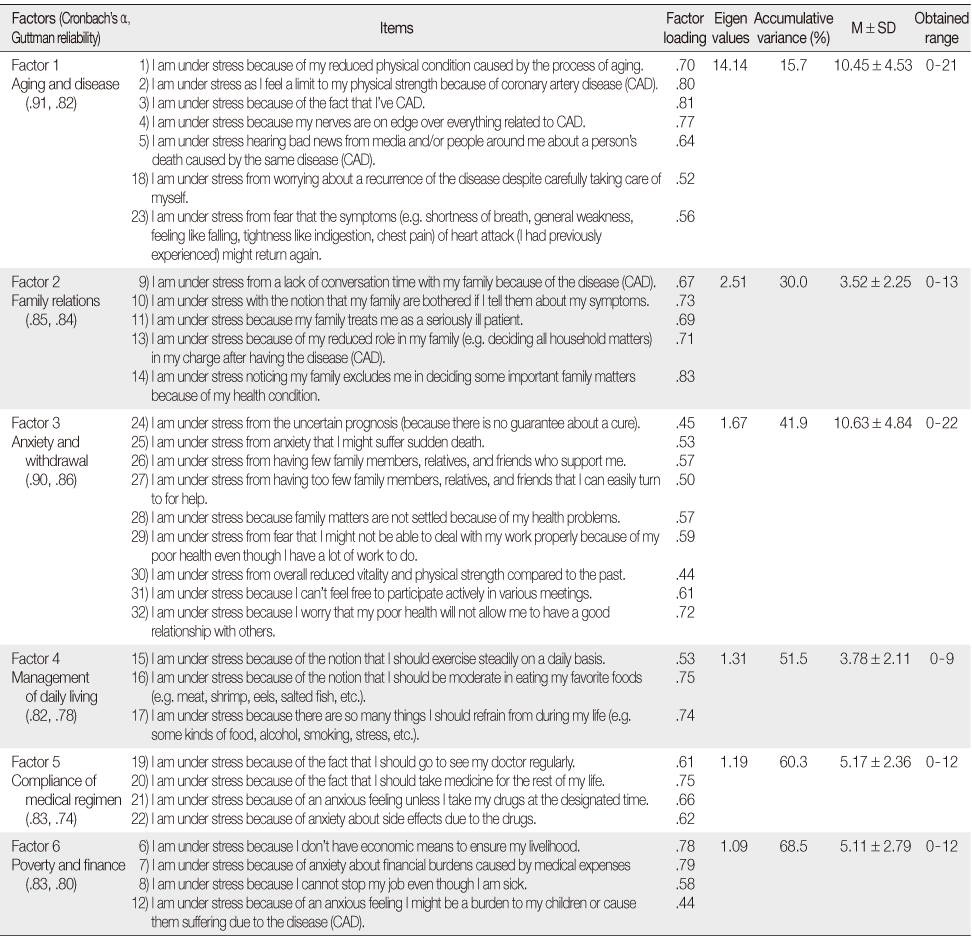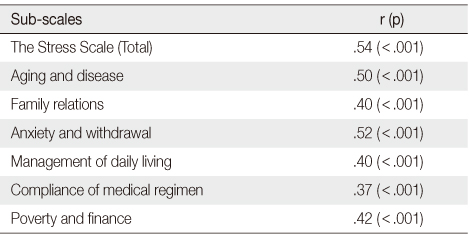Articles
- Page Path
- HOME > J Korean Acad Nurs > Volume 44(6); 2014 > Article
-
Original Article
- Development of a Stress Scale for Elderly Patients with Coronary Artery Disease
- Yun Ok Choi, Jeong Sun Kim
-
Journal of Korean Academy of Nursing 2014;44(6):630-638.
DOI: https://doi.org/10.4040/jkan.2014.44.6.630
Published online: December 31, 2014
1Chonnam National University Hospital, Regional Cardiocerebrovascular Center, Gwangju, Korea.
2College of Nursing, Chonnam National University, Gwangju, Korea.
- Address reprint requests to: Kim, Jeong Sun. College of Nursing, Chonnam National University, 160 Baekseo-ro, Dong-gu, Gwangju 501-746, Korea. Tel: +82-62-530-4957, Fax: +82-62-227-4009, kjs0114@jnu.ac.kr
© 2014 Korean Society of Nursing Science
This is an Open Access article distributed under the terms of the Creative Commons Attribution NoDerivs License. (http://creativecommons.org/licenses/by-nd/4.0/) If the original work is properly cited and retained without any modification or reproduction, it can be used and re-distributed in any format and medium.
Abstract
-
Purpose
- The purpose of this study was to develop a scale to evaluate stress in elderly patients with coronary artery diseases (CAD) and to examine validity and reliability of the scale.
-
Methods
- The development process for the preliminary scale included construction of a conceptual framework and initial items, verification of content analysis, sentence correction, and pilot study. This study was conducted using a questionnaire survey with one-to-one interviews during January and February, 2012. Participants were 240 elderly patients with CAD. Data were analyzed using item analysis, factor analysis, criterion related validity, and internal consistency.
-
Results
- The developed scale consisted of 32 items and 6 factors - aging and disease (7 items), family relations (5 items), anxiety and withdrawal (9 items), management of daily living (3 items), compliance of medical regimen (4 items), poverty and finance (4 items), and explained 68.5% of total variance. The scale had significantly positive correlation with the Korean Perceived Stress Scale (KPSS). Cronbach's alpha was .96, and Guttman split half coefficient was .91.
-
Conclusion
- Results indicate that the Stress Scale for Elderly Patients with CAD has validity and reliability, and is a suitable scale in health care settings to assess stress in elderly patients with CAD.
This manuscript is a revision of part of the first author's master's thesis from Chonnam National University.
- 1. Statistics Korea. 2012 annual report on the cause of death statistis [Internet]. Daejeon, Author. 2013;cited 2014 March. Available from: http://kostat.go.kr/portal/korea/kor_nw/2/6/2/index.board?bmode=read&aSeq=308559
- 2. Ministry of Health & Welfare, Korea Centers for Disease Control and Prevention. Korea health statistics 2012: Korea national health and nutrition examination survey (KNHANESV-3). Seoul: Ministry of Health & Welfare; 2013.
- 3. Cho JJ. Stress and cardiovascular disease. J Korean Med Assoc. 2013;56(6):462–470. http://dx.doi.org/10.5124/jkma.2013.56.6.462Article
- 4. Thrall G, Lane D, Carroll D, Lip GY. A systematic review of the effects of acute psychological stress and physical activity on haemorheology, coagulation, fibrinolysis and platelet reactivity: Implications for the pathogenesis of acute coronary syndromes. Thromb Res. 2007;120(6):819–847. http://dx.doi.org/10.1016/j.thromres.2007.01.004ArticlePubMed
- 5. Rosengren A, Hawken S, Ounpuu S, Sliwa K, Zubaid M, Almahmeed WA, et al. Association of psychosocial risk factors with risk of acute myocardial infarction in 11119 cases and 13648 controls from 52 countries (the INTERHEART study): Case-control study. Lancet. 2004;364(9438):953–962. http://dx.doi.org/10.1016/s0140-6736(04)17019-0ArticlePubMed
- 6. Jiang W, Samad Z, Boyle S, Becker RC, Williams R, Kuhn C, et al. Prevalence and clinical characteristics of mental stress-induced myocardial ischemia in patients with coronary heart disease. J Am Coll Cardiol. 2013;61(7):714–722. http://dx.doi.org/10.1016/j.jacc.2012.11.037ArticlePubMedPMC
- 7. Lakatta EG. Cardiovascular regulatory mechanisms in advanced age. Physiol Rev. 1993;73(2):413–467.ArticlePubMed
- 8. Jousilahti P, Vartiainen E, Tuomilehto J, Puska P. Sex, age, cardiovascular risk factors, and coronary heart disease: A prospective follow-up study of 14 786 middle-aged men and women in Finland. Circulation. 1999;99(9):1165–1172.ArticlePubMed
- 9. Boo S, Froelicher ES. Cardiovascular risk factors and 10-year risk for coronary heart disease in Korean women. Asian Nurs Res. 2012;6(1):1–8.Article
- 10. Feldman DN, Gade CL, Slotwiner AJ, Parikh M, Bergman G, Wong SC, et al. Comparison of outcomes of percutaneous coronary interventions in patients of three age groups (<60, 60 to 80, and >80 years) (from the New York State Angioplasty Registry). Am J Cardiol. 2006;98(10):1334–1339. http://dx.doi.org/10.1016/j.amjcard.2006.06.026PubMed
- 11. Seo IK, Ko MS. Effects of the elderly's abuse experiences on their suicidal ideation & mediation effects of stress, depression and social supports. Health Soc Welf Rev. 2011;31(1):127–157.Article
- 12. Kwon KN. The relationship between stress and pain in patient undergoing angiocardiography. J Korean Soc Ind Appl. 2004;7(4):317–324.
- 13. Kim JW, Koh KB. The relationship between perceived stress and coping strategies in patients with coronary artery disease. J Korean Neuropsychiatr Assoc. 2000;39(2):288–296.
- 14. Rafanelli C, Roncuzzi R, Milaneschi Y, Tomba E, Colistro MC, Pancaldi LG, et al. Stressful life events, depression and demoralization as risk factors for acute coronary heart disease. Psychother Psychosom. 2005;74(3):179–184. http://dx.doi.org/10.1159/000084003ArticlePubMedPDF
- 15. Kee BS, Oh SM, Kim CJ. Life event stress and coping strategy in the patients with coronary artery disease. J Korean Neuropsychiatr Assoc. 1998;37(2):243–250.
- 16. Lazarus RS, Folkman S. Stress, appraisal, and coping. New York, NY: Springer Publishing Company; 1984.
- 17. Neugarten BL. Age groups in American society and the rise of the young-old. Ann Am Acad Polit Soc Sci. 1974;415(1):187–198. http://dx.doi.org/10.1177/000271627441500114ArticlePDF
- 18. Kim GS. New Amos 16.0 analysis structural equation modeling. Seoul: Hannarae Publishing Co.; 2007.
- 19. Park JO, Seo YS. Validation of the perceived stress scale (PSS) on samples of Korean university students. Korean J Psychol Gen. 2010;29(3):611–629.
- 20. Youn HH, Kim MC. The stress, coping behavior and well-being of older adults. J Korea Gerontol Soc. 1994;14(1):17–32.
- 21. Lee YJ, Kim TH. A study on the buffering effect of social support on the stress of the elderly who lives alone. J Korea Gerontol Soc. 1999;19(3):79–93.
- 22. Kim JS, Choi YO, Shin SJ. Change of life in the middle age and elderly patients with ischemic heart disease (IHD) relapse after cardiovascular interventions. Qual Res. 2012;13(2):145–157.Article
- 23. Odell A, Grip L, Hallberg LR. Restenosis after percutaneous coronary intervention (PCI): Experiences from the patients' perspective. Eur J Cardiovasc Nurs. 2006;5(2):150–157. http://dx.doi.org/10.1016/j.ejcnurse.2005.10.004ArticlePubMedPDF
- 24. Chong YS, Jo SA, An JS, Jeong YJ. Effect of family relations as a source of meaning of life and self-transcendence value on successful aging in Korean elders. Korean J Dev Psychol. 2012;25(1):19–41.
- 25. Liu EH, Joventino LP, Buxton AE. Risk stratification for sudden death in patients with coronary artery disease. In: Gussak I, Antzelevitch C, editors. Electrical diseases of the heart: Volume 2: Diagnosis and treatment. 2nd ed. London, UK: Springer-Verlag; 2013. p. 339–362.
- 26. Kim JH, Oh HS, Min SH. Health life behavior and perceived stress of university students. J East Asian Soc Diet Life. 2004;14(3):207–216.
- 27. Lee YJ. An education program to modify lifestyle: Effects on health behavior and physiological parameters in patients with coronary disease. Clin Nurs Res. 2007;13(3):43–54.
- 28. Vlasic W. Nursing care of the client requiring percutaneous coronary intervention. Nurs Clin North Am. 2004;39(4):829–844. http://dx.doi.org/10.1016/j.cnur.2004.07.007ArticlePubMed
- 29. Andersen LB, Wedderkopp N, Hansen HS, Cooper AR, Froberg K. Biological cardiovascular risk factors cluster in Danish children and adolescents: The european youth heart study. Prev Med. 2003;37(4):363–367.ArticlePubMed
- 30. Statistics Korea. Elderly statistics 2013. Daejeon: Author; 2013.
- 31. Jung YH, Ko S. Estimating socioeconomic costs of five major disease. Korean J Public Financ. 2004;18(2):77–104.
REFERENCES
Figure & Data
REFERENCES
Citations

- Health-Related Quality of Life in Patients With Coronary Artery Disease Undergoing Percutaneous Coronary Intervention: A Cross-Sectional Study
Yujeong KIM
Journal of Nursing Research.2022; 30(1): e186. CrossRef - Characteristics of the Korean speakers' voice under easy Korean, difficult Korean and English reading situations
Ji-Eun Kim
Phonetics and Speech Sciences.2016; 8(1): 1. CrossRef
- We recommend
- Related articles
-
- Development and evaluation of a question-answering chatbot to provide information for patients with coronary artery disease after percutaneous coronary intervention
- Development and Validation of a Dignity in Care Scale of Terminally Ill Patients for Nurses
- Development of a Reward Scale for Hospital Nurses
- Influence of Illness Uncertainty on Health Behavior in Individuals with Coronary Artery Disease: A Path Analysis
Factor Analysis and Reliability (N=240)
Kaiser-Meyer-OIkin (KMO)=.94; Bartlett's test of sphericity χ2=5336.99 (p<.001); Cronbach's α=.96; Guttman reliability=.91.
Correlation between the Stress Scale and the Korean Perceived Stress Scale (KPSS) (N=240)
Kaiser-Meyer-OIkin (KMO)=.94; Bartlett's test of sphericity χ2=5336.99 (
 KSNS
KSNS
 E-SUBMISSION
E-SUBMISSION


 Cite
Cite

